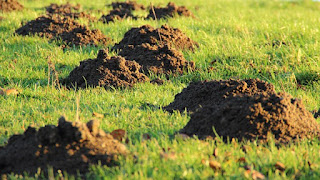Red Thread - Plan Your Attack on This Fungal Disease!
 |
| Joe Magazzi, President of Gr.E.A.T |
by Joe Magazzi
We have been receiving many questions about Red Thread and Pink
Patch, which are fungal diseases that can occur in turf grass. These diseases are usually easy to identify
by patches of pink or red discoloration on turf grass. These diseases tend to appear and be most
active when temperatures are around 70°F, but they can start to grow with
lower temperatures. These diseases also
appear during periods of wet weather, such as we have experienced in the
Northeast this Spring. Due to a
convergence of these warm and wet weather conditions, Red Thread and Pink Patch
are thriving and very prevalent in turf grass.
 |
| Red Thread at Joe's house |
Red Thread and Pink Patch are generally aesthetic diseases
that can be controlled both by adjusting your fertility and cultural
practices. However, in severe cases, these diseases (especially Red Thread)
can be destructive to rye grasses and fescues – species prevalent in the
northern part of the US. Therefore, for professionals who are maintaining turf
and for homeowners that are worried about the discoloration and potential
damage, Red Thread and Pink Patch can be easily and safely treated organically
with some simple practices & cost-effective organic products.
Green Earth Ag & Turf suggests that you first address
your cultural practices to reduce the occurrence of Red Thread, specifically
your fertility and water management programs. The following practices are
suggested, regardless of the stage of disease, and will help to reduce future
disease and pest outbreaks.
Fertility - Standard
dogma would say that Red Thread and Pink Patch are symptoms of low amounts of
nutrients in the soil, namely nitrogen. On
the contrary, we have heard from many applicators that adding nitrogen can
instigate the disease, and we often see it on golf courses where there is
more than adequate fertility. In
addition, adding nitrogen in cooler temperatures when soil biology is not
active and nutrient uptake is not optimal, may ultimately lead to more disease
outbreaks.
 |
| Steve Bousquet |
We spoke to Steve Bousquet, President of American Landscape and LawnScience, and past president of the Connecticut Nursery and Landscape Association, in order to get his opinion. Steve has
been using organic practices and products for many years, and he shares his approach for preventing Red Thread with us:
“Solving lawn fungus
issues is never easy. One of the best
ways to reduce lawn fungus is to reduce the amount of nitrogen applied to the
lawn. We use an organic approach, in
which we have chosen to reduce our nitrogen applications by 50% and we have
great results. We see less fungus on our
lawns compared to lawns being treated with heavy applications of nitrogen
during the season. Our company does not apply fungicides, so we focus on
reducing the conditions favorable to fungal growth and we choose to use slow
release organic fertilizers to keep fungal outbreaks to a minimum.”
Water Management -
Excess moisture is a factor that can lead to red thread and pink patch. Of
course, you can’t help it when Mother Nature provides above normal rainfall, as
was this case in New England this Spring. However, you can control your
irrigation practices, and you must work with the client to not over-water. Green Earth Ag & Turf strongly suggests deep watering,
less often as opposed to a little every day. Not only does this save you time
and money, it is also better for turf grass. It helps encourage better root
growth as the turf roots must grow downward to seek water deeper in the soil.
Additionally, excess water not used by the turf is used by disease and pests,
especially fungal diseases. This approach can reduce future outbreaks, saves
water as less evaporates from the surface, and the deeper root growth will give
turf grasses better access to nutrients in the soil as well!
Altering Cultural
Practices: In terms of mowing, keep blades sharp so they cut, rather than
tear and injure, the grass as a good general practice. Although we usually
suggest mulching your clippings, when
red thread is active you may want to remove the clippings from the lawn, as
the fungus that causes these diseases lives on the grass blades.
Suggested Organic
Disease Control: In more severe cases of Red Thread and Pink Patch, or in
cases where immediate treatment is desired or necessary, the use of organic
fungicides has been proven effective at controlling the disease. We suggest organic fungicides comprised of
hydrogen peroxide/dioxide such as the OMRI-Listed PERpose Plus,
which is more concentrated than standard peroxide products, is more cost
effective, and does not contain the potentially toxic peracetic acid. Hydrogen
peroxide/dioxide kills on contact then quickly breaks down to oxygen and water
making it much less toxic and pervasive than other fungicides; these resulting
components are beneficial to turf and soil as opposed to harmful, which may be
the case with other fungicides. The hydrogen peroxide/dioxide is more
superficial in its action, so it will have much less of a damaging effect on
beneficial organisms (and for a shorter duration of time). Please note: when using PERpose Plus, it
cannot be shipped via UPS. It must be
picked up at our Branford warehouse or shipped by freight for large orders, due
to federal regulations.
Red Thread and Pink Patch may be controlled easily, in many
cases with simple changes in cultural practices. Too much of a good thing, like
nitrogen or water, can provide perfect conditions for the disease to
flourish. For professionals, we are
happy to report that relatively benign organic fungicides, such as PERpose
Plus, can effectively bring infection under control and at a low cost. Give us
a call, if you are experiencing difficulties with these fungal diseases. Our number is 866-374-5101.




